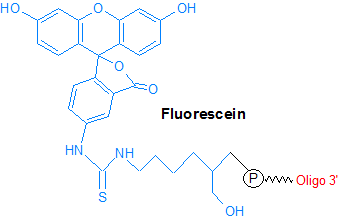
Modification : Fluorescein-3'
Catalog Reference Number
Category
Modification Code
5 Prime
3 Prime
Internal
Molecular Weight (mw)
Extinction Coeficient (ec)
Technical Info (pdf)
Absorbance MAX
Emission MAX
Absorbance EC
26-6595
Fluorescent Dyes
[Fl-3]
N
Y
N
537.46
31.5
PS26-6595.pdf
494
521
31.5
| Catalog No | Scale | Price |
| 26-6595-05 | 50 nmol | $68.00 |
| 26-6595-02 | 200 nmol | $68.00 |
| 26-6595-01 | 1 umol | $88.00 |
| 26-6595-03 | 2 umol | $133.00 |
| 26-6595-06 | 5 umol | $396.00 |
| 26-6595-10 | 10 umol | $708.00 |
| 26-6595-15 | 15 umol | $885.00 |
Fluorescein is the most commonly used fluorescent dye for labeling oligonucleotides and is also known as FITC (Fluorescein isothiocyanate). Fluorescein has an absorbance maximum of 494 nm and an emission maximum of 521 nm. The difference between the fluorescein and 6-FAM modifications is that here the fluorescein dye is attached to the 6-carbon spacer via an N-hydroxysuccinimide (NHS) group instead of a carboxy group. Fluorescein plays a particularly important role in real-time PCR applications, being used as a reporter moiety in TaqMan probes (1), Scorpion primers (2) and Molecular Beacons (3). For such probes, fluorescein is most commonly paired with the dark quencher BHQ-1, as the two have excellent spectral overlap.
Fluorescein can be used to label DNA oligos for use as hybridization probes in a variety of in vivo and in vitro research or diagnostic applications, as well as for structure-function studies of DNA, RNA, and protein-oligonucleotide complexes. Oligos labeled with fluorescein at the 5' end can be used as PCR and DNA sequencing primers to generate fluorescently-labeled PCR, sequencing or genetic analysis (AFLP or microsatellite) products.
References
1. Livak, K.J., Flood, S.J.A., Marmaro, J., Giusti, W., Deetz, K. Oligonucleotides with fluorescent dyes at opposite ends provide a quenched probe system useful for detecting PCR product and nucleic acid hybridization.
PCR Methods Appl. (1995),
4: 1-6.
2. Thelwell, N., Millington, S., Solinas, A., Booth, J., Brown, T. Mode of action and application of Scorpion primers to mutation detection.
Nucleic Acids Res. (2000),
28: 3752-3761.
3. Tyagi, S., Kramer, F.R. Molecular beacons: probes that fluoresce upon hybridization.
Nat. Biotechnol. (1996),
14: 303-308.
- Fluorescein-3' (FITC)
